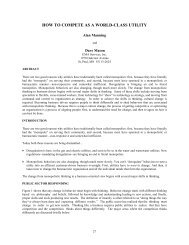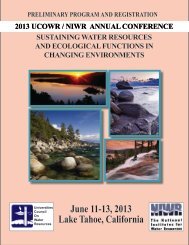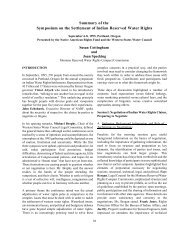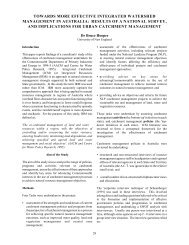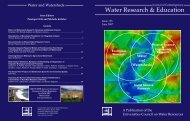10Cardwell. Cole, Cartwright, <strong>and</strong> MartinNational Environmental Policy Act. Together withNEPA, they provide the U. S. Federal governmentwith a planning framework <strong>and</strong> enforceablest<strong>and</strong>ards for protecting environment quality <strong>and</strong>authority for restoring degraded environmentalquality. Arguably most important <strong>of</strong> many thatinfluence water resources management are theClean <strong>Water</strong> Act (which required restoration <strong>of</strong>the physical, biological, <strong>and</strong> chemical integrity<strong>of</strong> national waters), the Endangered Species Act(which directs the protection <strong>and</strong> recovery <strong>of</strong>species at risk <strong>of</strong> extinction to a viable, sustainablestate), <strong>and</strong> various water resource development actsthat prescribe management actions for the nation’swaterways, including restoration <strong>of</strong> ecosystems inorder to recover damaged environmental quality toa more sustainable condition.At the direction <strong>of</strong> the 1965 <strong>Water</strong> ResourcesPlanning Act, a <strong>Water</strong> Resources Council wascreated to coordinate overarching federal poli-cy. Before it was disb<strong>and</strong>ed in 1983, it wrote thePrinciples <strong>and</strong> Guidelines for <strong>Water</strong> <strong>and</strong> RelatedL<strong>and</strong>-Resources Management (U.S. <strong>Water</strong> Re-sources Council 1983), which set forth the federalobjective for water resources project planning. Theobjective incorporated the NEPA principle <strong>and</strong> thest<strong>and</strong>ards set by other environmental laws to assureenvironmental protection at projects. It di-rected federal water resources investment projectsto “contribute to national economic development(NED) consistent with protecting the Nation’senvironment, pursuant to national environmentalstatutes…” Consideration <strong>of</strong> environmental qual-ity (EQ), regional economic development (RED),<strong>and</strong> other social effects is also explicitly allowedthrough additional “accounts.”Meanwhile, an important concept was evolvingprimarily in the international arena <strong>of</strong> the UnitedNations. With the establishment <strong>of</strong> the WorldCommission on Environment <strong>and</strong> Development,also known as the Brundtl<strong>and</strong> Commission, bythe U.N. <strong>and</strong> the publication <strong>of</strong> its report entitled“Our Common Future” (World Commission onEnvironment <strong>and</strong> Development 1987), the termssustainable development <strong>and</strong> sustainability becamemuch more commonly a part <strong>of</strong> natural resource<strong>and</strong> environmental management vocabulary <strong>and</strong>thinking. The Commission defined sustainabledevelopment as development “..to meet the needs<strong>of</strong> the present generation without compromisingthe ability <strong>of</strong> future generations to meet their ownneeds.” The World Bank incorporated this concept<strong>of</strong> sustainable development into its policies <strong>and</strong>defined its relationship to concepts <strong>of</strong> economic,environmental, <strong>and</strong> social sustainability (Goodl<strong>and</strong><strong>and</strong> Daly 1996). In 1993 the President’s Councilon Sustainable Development (PCSD) was tasked“to develop bold, new approaches to integrateeconomic, environmental <strong>and</strong> equity issues” <strong>and</strong>highlighted sustainable development as a nationalgoal for resource management in its 1996 report(President’s Council on Sustainable Development1996).Within this context <strong>of</strong> national policydevelopment, evolution <strong>of</strong> policies <strong>and</strong> goalswithin the water resource management agenciesis illustrated by the policies <strong>of</strong> the largest waterresources management program, the Civil WorksProgram <strong>of</strong> the U.S. Army Corps <strong>of</strong> Engineers(Loucks 2003). The goals <strong>of</strong> the Civil WorksProgram are presented in various documentsincluding the Civil Works Strategic Plan, PolicyGuidance Letter 61, the Environmental OperatingPrinciples, <strong>and</strong> its Engineering Regulation 1105-2-100 - the implementing guidance for the Principles<strong>and</strong> Guidelines <strong>and</strong> for ecosystem restorationplanning (U.S. Army Corps <strong>of</strong> Engineers 2000).Policy Guidance Letter 61 (PGL 61, U.S. ArmyCorps <strong>of</strong> Engineers 1999) presents policy forapplying a watershed perspective to Corps’ waterresources management, including a goal to guideapplication. Although PGL 61 does not mentionIWRM specifically, the policy for applying awatershed perspective aligns with the concept <strong>of</strong>IWRM presented above. The goal is to assuresustainable use <strong>of</strong> water resources, taking intoaccount environmental protection, economicdevelopment, <strong>and</strong> social well-being. This goalwas derived from the President’s Council onSustainable Development <strong>and</strong> is consistent with asustainable development goal generally accepted byThe World Bank <strong>and</strong> achieved through economic,environmental, <strong>and</strong> social sustainability (Goodman<strong>and</strong> Daly 1996).The Environmental Operating Principles (U.S.Army Corps <strong>of</strong> Engineers 2002) describe how toconduct practices within the Corps with the goal<strong>of</strong> environmental sustainability, pursued throughUCOWRJOURNAL OF CONTEMPORARY WATER RESEARCH & EDUCATION
IWRM: Defi nitions <strong>and</strong> Conceptual Musings11“a synergistic process whereby environmental <strong>and</strong>economic considerations are effectively balancedthrough the life cycle <strong>of</strong> project planning, design,construction, operation <strong>and</strong> maintenance to improvethe quality <strong>of</strong> life for present <strong>and</strong> future generations.”The doctrine behind the Environmental OperatingPrinciples recognized the great influence <strong>of</strong> thesustainable development concept developed by theBrundtl<strong>and</strong> Commission.Thirdly, the Strategic Plan for the Corps’ CivilWorks Program (U.S. Army Corps <strong>of</strong> Engineers2004) specifically promotes “Integrated <strong>Water</strong>Resources Management <strong>and</strong> a watershed focus”as a means to achieve five strategic goals, the first<strong>of</strong> which is to “provide sustainable development<strong>and</strong> integrated management <strong>of</strong> the nation’s waterresources.” The Strategic Plan sets a vision forthe Corps “as the premier public service provider<strong>of</strong> comprehensive, sustainable solutions for waterchallenges through integrated water resourcesmanagement.”The goals from the U.S. federal policydocuments (Table 1) indicate that the definition<strong>of</strong> “sustainable development” as the nationalgoal for water resources management, is fullyconsistent, not only with guidance within theCorps, but also with national goals for naturalresources management outlined by the NationalEnvironmental Policy Act, the President’s Councilon Sustainable Development <strong>and</strong> the Principles<strong>and</strong> Guidelines. However, any law or other clearstatement <strong>of</strong> national policy that explicitly states sohas yet to emerge. A sustainable development goalis unevenly acknowledged among agencies <strong>and</strong>its relationship to IWRM remains unclear. Whilethe goal <strong>of</strong> IWRM within the Corps’ Civil WorksProgram appears to be sustainable development,IWRM is not clearly stated as such in the CivilWorks Strategic Plan. Thus, while the concepts <strong>of</strong>sustainable development <strong>and</strong> IWRM have recentlybecome prominent in U.S. water resources policy,they remain fragmented <strong>and</strong> evolutionary. Cleardeclaration <strong>of</strong> the relationship between IWRM <strong>and</strong>sustainable development could be the next majorstep in advancing water resources managementtoward a more coherent integration into national<strong>and</strong> international visions <strong>of</strong> a sustainable earth.Table 1. U.S. policy statements that help define a U.S. national goal for Integrated <strong>Water</strong> Resources Management(organized chronologically from 1969 to 2004).NEPASourcePrinciples <strong>and</strong> GuidelinesPresident’s Commissionon Sustainable DevelopmentReportPolicy Guidance Letter 61Environmental OperatingPrinciplesArmy Corps Strategic PlanGoalEncourage productive <strong>and</strong> enjoyable harmony between man <strong>and</strong> his environment;promote efforts which will prevent or eliminate damage to the environment<strong>and</strong> biosphere <strong>and</strong> stimulate the health <strong>and</strong> welfare <strong>of</strong> man; enrich theunderst<strong>and</strong>ing <strong>of</strong> ecological systems <strong>and</strong> natural resources important to thenationTo contribute to national economic development consistent with protecting thenation’s environment, pursuant to national environmental statutesA sustainable United States will have a growing economy that provides equitableopportunities for satisfying livelihoods <strong>and</strong> a safe, healthy, high quality <strong>of</strong>life for current <strong>and</strong> future generations. Our nation will protect its environment,its natural resource base, <strong>and</strong> the functions <strong>and</strong> viability <strong>of</strong> natural systems onwhich all life depends… Sustainability as balancing <strong>of</strong> three major elements:environmental health, economic prosperity <strong>and</strong> social well-beingUse <strong>of</strong> water resources in a manner that is sustainable, taking into account environmentalprotection, economic development, <strong>and</strong> social well beingSeek balance <strong>and</strong> synergy among human development activities <strong>and</strong> naturalsystems by designing economic <strong>and</strong> environmental solutions that support <strong>and</strong>reinforce one another.Provide sustainable development <strong>and</strong> integrated management <strong>of</strong> the nation’swater resources.JOURNAL OF CONTEMPORARY WATER RESEARCH & EDUCATIONUCOWR
- Page 3: Journal of ContemporaryWater Resear
- Page 6 and 7: 2Bruce Hooperinstitutional, and tem
- Page 11 and 12: IWRM: Governance, Best Practice, an
- Page 13: IWRM: Defi nitions and Conceptual M
- Page 17 and 18: IWRM: Defi nitions and Conceptual M
- Page 19: IWRM: Defi nitions and Conceptual M
- Page 22 and 23: 18Cardwell. Cole, Cartwright, and M
- Page 24 and 25: 20Mostert26 water boards responsibl
- Page 26 and 27: 22MostertTable 1. Third National Wa
- Page 28 and 29: 24MostertImplementationThe ambitiou
- Page 30 and 31: 26MostertBiswas, A. K. 2004b. Respo
- Page 32 and 33: 28UNIVERSITIES COUNCIL ON WATER RES
- Page 34 and 35: 30Ashton, Turton, and Rouxresource
- Page 36 and 37: 32Ashton, Turton, and Rouxassumptio
- Page 38 and 39: 34Ashton, Turton, and RouxEffective
- Page 40 and 41: 36UNIVERSITIES COUNCIL ON WATER RES
- Page 42 and 43: 38Hussey and Doversin water policy
- Page 44 and 45: 40Hussey and Dovers1994 Council of
- Page 46 and 47: 42Hussey and Doversestablished Thes
- Page 48 and 49: 44Hussey and DoversTable 1. Typolog
- Page 50 and 51: 46Hussey and Doversassessment appro
- Page 52 and 53: 48Hussey and Doverspolicy goals.Bey
- Page 54 and 55: 50Hussey and DoversFrawley, K. 1994
- Page 56 and 57: 52Mitchelloften took three to four
- Page 58 and 59: 54Mitchelltree preservation plans;
- Page 60 and 61: 56UNIVERSITIES COUNCIL ON WATER RES
- Page 62 and 63: 58Genskow and Borna series of chall
- Page 64 and 65:
60Genskow and BornTable 1. Watershe
- Page 66 and 67:
62Genskow and Bornthe first Dungene
- Page 68 and 69:
64Genskow and BornWashington, DC.Ko
- Page 70 and 71:
66Green and Fernández-BilbaoWithin
- Page 72 and 73:
68Green and Fernández-Bilbaosubjec
- Page 74 and 75:
70Green and Fernández-Bilbaoinflue
- Page 76 and 77:
72Green and Fernández-BilbaoBerbel
- Page 78 and 79:
74UNIVERSITIES COUNCIL ON WATER RES
- Page 80 and 81:
76BallweberEstablish AdvisoryCommit
- Page 82 and 83:
78Ballweberattributes in others (Ch
- Page 84 and 85:
80UNIVERSITIES COUNCIL ON WATER RES
- Page 86 and 87:
82Barreiraand ground water. To this
- Page 88 and 89:
84Barreirawith other states for int
- Page 90 and 91:
86UNIVERSITIES COUNCIL ON WATER RES
- Page 92 and 93:
88Davis and ThrelfallResource Manag
- Page 94 and 95:
90Davis and ThrelfallTable 2. Thirt
- Page 96 and 97:
92Davis and Threlfallby regional an
- Page 98 and 99:
94Davis and Threlfallenforcement, a
- Page 100 and 101:
96Davis and Threlfallhusbandry prac
- Page 102 and 103:
98Davis and ThrelfallNew Zealand: T
- Page 104 and 105:
100UNIVERSITIES COUNCIL ON WATER RE
- Page 106 and 107:
102Lamoree and van SteenbergenIt is
- Page 108 and 109:
104Lamoree and van Steenbergenand n
- Page 110 and 111:
106Lamoree and van Steenbergeninter
- Page 112 and 113:
108BourgetWorks Planner Capability
- Page 114 and 115:
110Bourgetwith over 600 people resp
- Page 116 and 117:
112Bourgetgovernment’s intrusion
- Page 118 and 119:
114Bourget4.management, drought man
- Page 120 and 121:
116McKayFigure 1. The four paradigm
- Page 122 and 123:
118McKay4. Paradigm 4 (which commen
- Page 124 and 125:
120McKaythree main functions:1. ass
- Page 126 and 127:
122McKayState Implementation of the
- Page 128 and 129:
124McKayTable 2. Corporate governan
- Page 130 and 131:
126McKayFigure 4. Qu. 26 - The ESD
- Page 132 and 133:
128McKayFigure 7. Qu.93- This organ
- Page 134 and 135:
130McKayBrundtland Report. 1987. Ou
- Page 136 and 137:
132UCOWR BOARD OF DIRECTORS/COMMITT
- Page 138 and 139:
134BENEFITS OF UCOWR MEMBERSHIPThe
- Page 140 and 141:
136Past Issues of the Journal of Co
- Page 142 and 143:
138Academic Organizations Membershi
- Page 144 and 145:
140Individual Membership Applicatio
- Page 146 and 147:
Universities Council on Water Resou
- Page 148:
Integrated Water Resources Manageme



